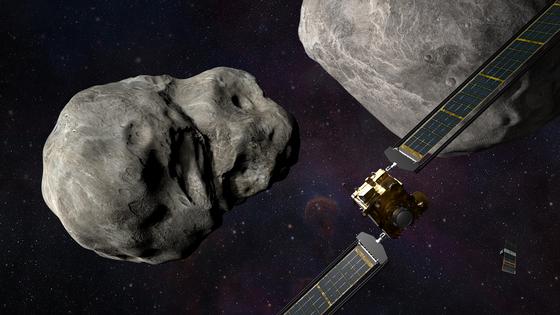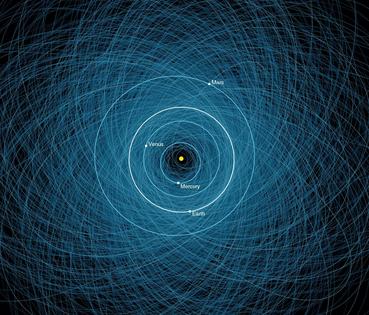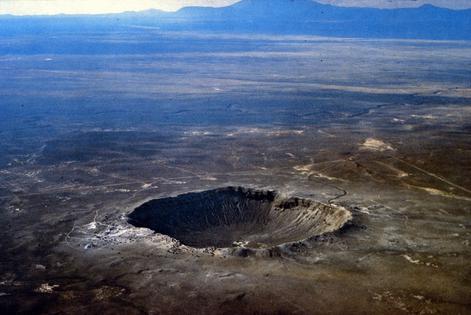NASA is crashing a spacecraft into an asteroid to test a plan that could one day save Earth from catastrophe
Published in Science & Technology News
On Sept. 26, 2022, NASA plans to change an asteroid’s orbit.
The large binary asteroid Didymos and its moonlet Dimorphos currently pose no threat to Earth. But by crashing a 1,340-pound (610-kilogram) probe into Didymos’ moon at a speed of approximately 14,000 mph (22,500 kph), NASA is going to complete the world’s first full-scale planetary defense mission as a proof of concept. This mission is called the Double Asteroid Redirection Test, or DART.
I am a scholar who studies space and international security, and it is my job to ask what the likelihood really is of an object crashing into the planet – and whether governments are spending enough money to prevent such an event.
To find the answers to these questions, one has to know what near-Earth objects are out there. To date, NASA has tracked only an estimated 40% of the bigger ones. Surprise asteroids have visited Earth in the past and will undoubtedly do so in the future. Experiments like the DART mission may help prepare humanity for such an event.
Millions of cosmic bodies, like asteroids and comets, orbit the Sun and often crash into the Earth. Most of these are too small to pose a threat, but some can be cause for concern. Near-Earth objects include asteroids and comets whose orbits will bring them within 120 million miles (193 million kilometers) of the Sun.
Astronomers consider a near-Earth object a threat if it will come within 4.6 million miles (7.4 million kilometers) of the planet and if it is at least 460 feet (140 meters) in diameter. If a celestial body of this size crashed into Earth, it could destroy an entire city and cause extreme regional devastation. Larger objects – 0.6 miles (1 kilometer) or more – could have global effects and even cause mass extinctions.
The most famous and destructive celestial impact took place 65 million years ago when an asteroid with a 6-mile (10-kilometer) diameter crashed into what is now the Yucatán Peninsula. It wiped out most plant and animal species on Earth, including the dinosaurs.
But smaller objects can also cause significant damage. In 1908, an approximately 164-foot (50-meter) celestial body exploded over the Podkamennaya Tunguska River in Siberia. It leveled more than 80 million trees over 830 square miles (2,100 square kilometers). In 2013, an asteroid only 65 feet (20 meters) across burst in the atmosphere 20 miles (32 kilometers) above Chelyabinsk, Russia. It released the equivalent of 30 Hiroshima bombs’ worth of energy, injured over 1,100 people and caused US$33 million in damage.
The likely next asteroid of substantial size to potentially hit Earth is asteroid 2005 ED224. When the 164-foot (50-meter) asteroid passes by on March 11, 2023, there is roughly a 1 in 500,000 chance of impact.
While the chances of a larger cosmic body striking Earth are small, the devastation would be enormous.
Congress recognized this threat, and in the 1998 Spaceguard Survey, it tasked NASA to find and track 90% of the estimated total of near-Earth objects 0.6 miles (1 kilometer) across or bigger within 10 years. NASA surpassed the 90% goal in 2011.
In 2005, Congress passed another bill requiring NASA to expand its search and track at least 90% of all near-Earth objects 460 feet (140 meters) or larger by the end of 2020. That year has come and gone and, mostly because of a lack of financial resources, only 40% of those objects have been mapped.
As of Sept. 18, 2022, astronomers have located 29,724 near-Earth asteroids, of which 10,189 are 460 feet (140 meters) or larger in diameter and 855 are at least 0.6 miles (1 kilometer) across. About 30 new objects are added each week.
A new mission funded by Congress in 2018 is scheduled in 2026 to launch an infrared space-based telescope – NEO Surveyor – dedicated to searching for potentially dangerous asteroids.
We can prevent a disaster only if we know it is coming, and asteroids have sneaked up on Earth before.
A so-called “city-killer” asteroid the size of a football field passed less than 45,000 miles (72,420 kilometers) from Earth in 2019. An asteroid the size of a 747 jet came close in 2021, as did an asteroid 0.6 miles (1 kilometer) wide in 2012. Each of these was discovered only about a day before it passed Earth.
Research suggests that Earth’s rotation creates a blind spot, hiding some asteroids from detection or making them appear stationary. This may be a problem, as some surprise asteroids do not miss us. In 2008, astronomers spotted a small asteroid only 19 hours before it crashed into rural Sudan.
The recent discovery of an asteroid 1.2 miles (2 kilometers) in diameter suggests that there are still big objects lurking.
To protect the planet from cosmic dangers, early detection is key. At the 2021 Planetary Defense Conference, scientists recommended a minimum of five to 10 years’ preparation time to mount a successful defense against hazardous asteroids.
If astronomers find a dangerous object, there are four ways to mitigate a disaster. The first involves regional first-aid and evacuation measures. A second approach would involve sending a spacecraft to fly near a small- or medium-sized asteroid; the gravity of the craft would slowly change the object’s orbit. To change a bigger asteroid’s path, we can either crash something into it at high speed or detonate a nuclear warhead nearby.
The DART mission will be the first-ever attempt to deflect a large asteroid. But this will not be the first time humanity has sent something to an asteroid. NASA’s Deep Space Impact mission crashed a probe into the comet 9P/Tempel in 2005 to take scientific measurements of the comet, and in 2018 Japan’s Hayabusa2 mission collected samples from the asteroid Ryugu and brought them back to Earth, but neither of these was designed as a planetary defense test.
The DART mission should generate a lot of useful information. This data will come from a camera aboard the DART spacecraft that will send images back to Earth up until the time of impact. In addition, a tiny satellite called LICIACube that was deployed from DART on Sept. 11, 2022, will take photos of the impact. A follow-up mission from the European Space Agency, called Hera, will launch in 2024 and rendezvous with Didymos in 2026 to begin collecting data.
In 2021, NASA’s planetary defense budget was $158 million, just 0.7% of NASA’s total budget and 0.02% of the roughly $700 billion U.S. defense budget.
Is this the right amount to invest in monitoring the skies, given the fact that some 60% of all potentially dangerous asteroids remain undetected? This is an important question to ask when one considers the potential consequences.
Investing in planetary defense is akin to buying homeowners insurance. The likelihood of experiencing an event that destroys your house is small, yet people buy insurance nonetheless.
If even a single object larger than 460 feet (140 meters) hits the planet, the devastation and loss of life would be extreme. A bigger impact could quite literally wipe out most species on Earth. Even if no such body is expected to hit Earth in the next 100 years, the chance is not zero. In this low-likelihood-versus-high-consequences scenario, investing in protecting the planet from dangerous cosmic objects may give humanity some peace of mind and could prevent a catastrophe.
This is an updated version of a story originally published on March 1, 2022.
This article is republished from The Conversation, an independent nonprofit news site dedicated to sharing ideas from academic experts. It was written by: Svetla Ben-Itzhak, Air University. The Conversation has a variety of fascinating free newsletters.
Read more:
Touching the asteroid Ryugu revealed secrets of its surface and changing orbit
Bringing Mars rocks back to Earth: On Feb. 18, Perseverance Rover landed safely on Mars – a lead scientist explains the tech and goals
The views expressed are those of the author and do not reflect the official position of the U.S. Department of Defense, or of any organization the author is affiliated with, including the Air University, Air War College, the U.S. Air Force and the U.S. Space Force.













Comments